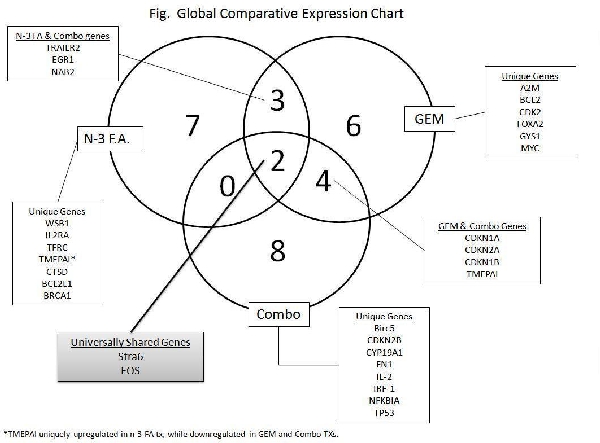Background: This study aims to establish molecular level changes that promote omega-3 fatty acids (Ω-3 FA) as an effective adjuvant to current gold-standard chemotherapeutic agent gemcitabine (GEM) for treatment on pancreatic cancer cells. Methods: MIA PaCa-2 pancreatic cancer cell line was cultured using standard protocol in DMEM (control) and treated with 100µm Ω-3 FA emulsion (95µm EPA and 78µm DHA), 100µm GEM and a combination treatment of 100µm Ω-3 FA emulsion and 100µm GEM for 12 hours at 37C and 5% CO2. Cells were isolated, homogenized and RNA was extracted using Qiagen RNeasy columns. Microarray analysis was performed using a 60-mer oligonucleotide array consisting of 113 genes (Superarray). Data was analyzed with minimal value background subtraction and interquartile normalization for all non-bleeding spots. Significance was determined as a 1.5-fold difference in expression relative to DMEM treatment. Results: Microarray analysis revealed 41 significantly expressed genes among all treatment groups (Fig. 1). Ω-3, GEM and Combination treatments exclusively expressed 7, 8 and 8 significant genes, respectively (Fig. 1). Interestingly, the 8 genes exclusive to combination treatment: BIRC5, CDKN2B, CYP19A1, FN1, IL-2, IRF-1, NFKBIA and TP53, are associated with restoration of cell cycle regulation, apoptosis and cell adhesion. Corresponding gene ontology reveals biological processes including diminished caspase inhibition, cell cycle arrest, regulation of proliferation with enhanced mitotic control at G1/S and G2/M checkpoints and oxidoreductase activity. Conclusion: This genetic expression profile provides evidence for Ω-3 FA synergistic potentiation of cytotoxic therapy through cell-cycle regulation, restored apoptosis signaling and cell adhesion changes not seen in GEM treatment alone. Future studies include RT-PCR confirmation, protein level analysis and selective genetic knockdown studies.
 500 Cummings Center
500 Cummings Center +1 978-927-8330
+1 978-927-8330
 +1 978-524-0461
+1 978-524-0461